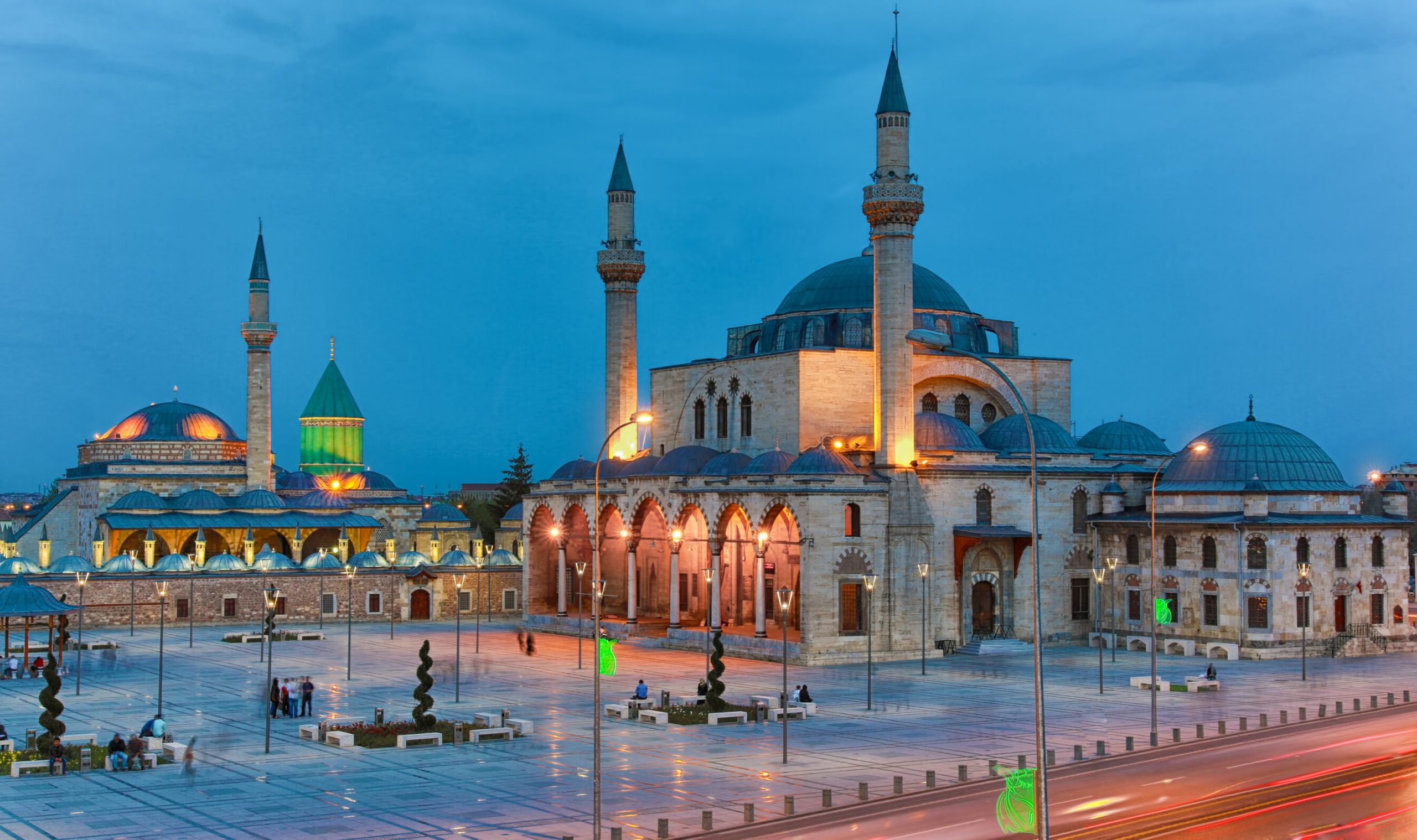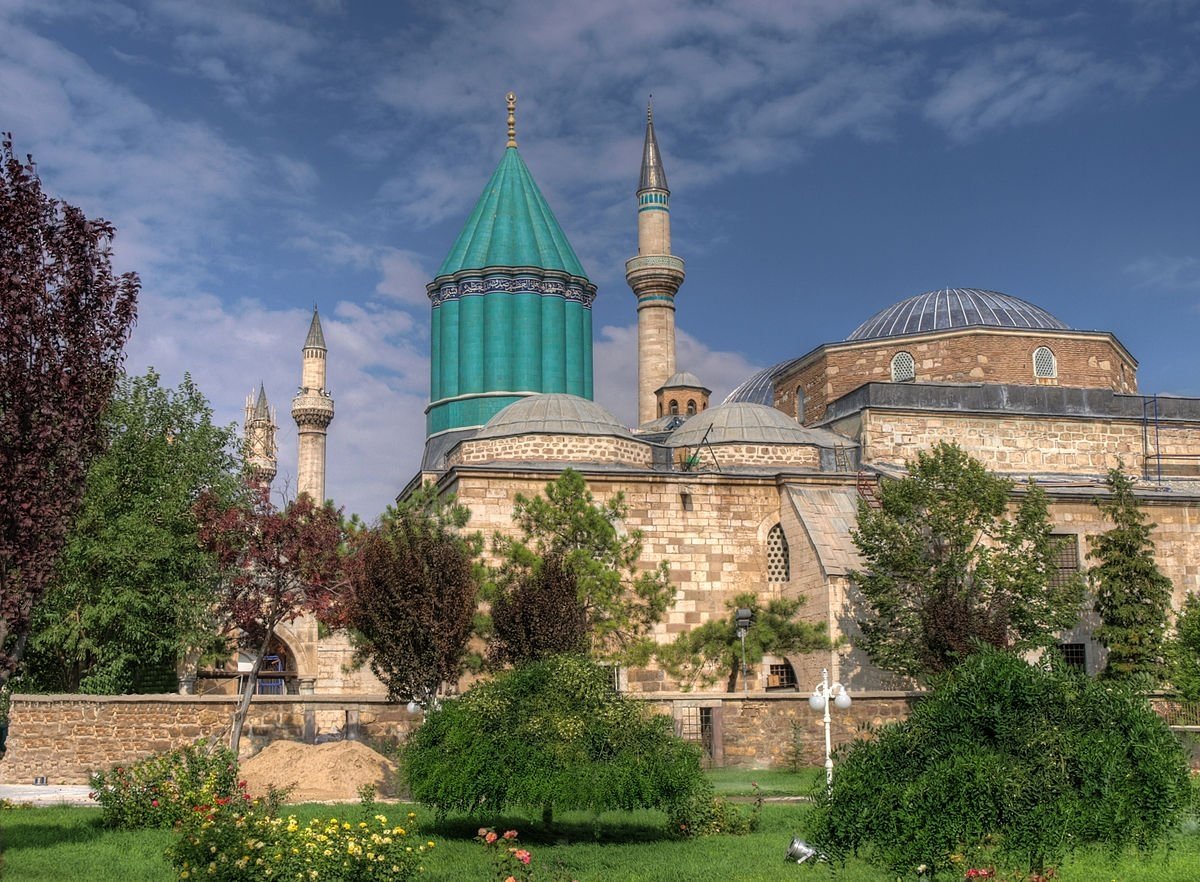In Search of Rumi
Forsake the beaten paths of tourists’ Turkey to trek through the mountains of Kurdistan to visit the shrine of one of the world’s most revered mystics, the 13th century Hazrath Jalaluddin Rumi –YOGINDER SIKAND

Partly in Asia and partly in Europe, Turkey is one of the most fascinating countries to visit. I had been to Turkey (pop. 84 million) twice before, on both trips confining myself to Istanbul, the world’s only city that straddles two continents (Asia and Europe), and nearby towns in the western part of the country — the well-beaten tourist trail.

Hadriyanus Kapisi
But on my latest trip, I was determined to explore other Turkish regions including those visited by few foreign travelers. I was certain that I wanted to visit Konya, which hosts the shrine of one of the world’s most revered mystics, the 13th century Hazrat Jalaluddin Rumi. I also wanted to trek the mountains of Kurdistan, the vast eastern part of Turkey adjoining Syria and Iran, where Sufi communities, for many decades persecuted by Turkey’s formerly radical secularist Kemalist regime, still exist. This time I wanted to experience Turkey’s rapidly fading, but once glorious, Sufi past.
The cheapest ticket I could procure to Turkey entailed arriving in the town of Antalya (pop. 1.3 million), of which I had not heard. Antalya, I was to discover, is one of Turkey’s most attractive holiday resorts, with a mild Mediterranean climate almost through the year, long, palm fringed beaches, ancient mosques and castles and, above all, endearingly welcoming people.
I checked into an old Ottoman building renovated and converted into a lodge. A little pool was the centre of an ornately decorated courtyard, surrounded by easy lounges — the sort one imagines Ottoman princes and nobility would have taken their ease. Calligraphy engravings on the walls gave an inkling of what life must have been for Ottoman elites a century ago.
Like most towns of Turkey, Antalya presents a fine blend of cultures. The majestic Hadriyanus Kapisi in the heart of the city is a massive gate built by Roman Emperor Hadrian, and dates back to the second century AD. Close by are ancient monuments, including several finely decorated mosques and Sufi lodges. The port, dating back to Roman times, is Antalya’s most attractive quarter, dotted with old cottages overlooking a natural harbour, comprising massive rocks. The sea is unimaginably placid like a giant swimming pool. A narrow donkey-track, fringed with flaming bougainvillea, leads down to the beach at the far end, while on the other side, below a Roman lighthouse, sailing and fishing boats, in a splendid variety of shades and colours, bob on calm waters.
The well-maintained 30,000 sq mts vast City Museum houses exhibits stretching back 10,000 years, to the Stone Age, through the Hittite, Greek, Roman, Christian Byzantine and Islamic eras of Turkish history. Its most curious item is the purported skull of Santa Claus, who, a plaque explains, was the bishop of a town near Antalya in the fourth century and is remembered as a friend of the poor and needy. Much later he was transformed into that rosy-cheeked reindeer-riding figure of fanciful European imagination.
Sipping bitter-sweet Turkish coffee at roadside cafes, playing backgammon with children, discussing religion and mysticism with old men in ancient mosques and downing endless plates of kababs and pilaf, I spent almost a week discovering the delights of Antalyan hospitality and bonhomie.

Diyarbakir
Accommodation options in Antalya. High-end: Swandor Hotels and Resorts (Rs.12,176 per night), Ramada Plaza (Rs.7,998), Double Tree by Hilton (Rs.6,298); Mid-range: Afflon Loft City Hotel (Rs.4,400), Antalya Inn Hotel (Rs.3,486), AG Hotels (Rs.3,308); Budget: On Hotel (Rs.2,542), Mai Inci Hotel (Rs.2,127), Grand Antalya Hotel (Rs.2,062).
After wallowing in the comfort of Antalya, I headed east, into the rugged mountains of eastern Turkey, inhabited by fiercely independent Kurdish clans. Although citizens of Turkey, the country’s 25 million Kurds are an ethnically distinct people — once a nation dispossessed of their territory which was divided between Iraq, Iran, Syria and Turkey after the First World War (1914-18). Since then all these countries have been equally hostile to Kurdish demands for autonomy, let alone independence.
Kurds constitute about a fifth of Turkey’s population and have been at loggerheads with the government in Ankara for decades. Stern laws have been imposed on Kurds, and they have often resorted to armed conflict to press their demands. Till recently, it was a punishable offence in Turkey to even speak Kurdish. But now, with flexible government policies and the discovery of oil in the region, things are beginning to change. Kurdish eastern Turkey, however, still remains distinctly poorer than the rest of the country.
Nevertheless Turkish Kurdistan is a treasure-trove of historical sites tucked in the lap of towering mountains. Crossing the vast (almost 700,000 sq. km), dry Anatolian plateau by bus, it took three days to reach the oil town of Gaziantep (pop.2 million), the starting point of my journey into Kurd-inhabited mountains. The drive from there further east traversed barren countryside, interspersed with tiny oases and dry grazing pastures.

Gaziantep
As the sun slipped below the mountains, we got to the town of Diyarbakir (pop. 1.7 million), on the banks of the River Tigris, with a history dating back to 1500 BCE. Approaching the town from the river below, we passed through a massive gate of a several centuries old wall encircling the town, the largest worldwide after the Great Wall of China. With old, crumbling mansions, ancient mosques and madrasas and people sporting traditional attire, this part of town is a stark contrast to the new quarter, featuring sprawling gardens, public fountains, posh apartment blocks, mobile-phone-totting youth and women in hip western wear.
I hesitated to spend the night in Dayarbakir, apprehensive of the massive military presence in the town, but there was no choice. Next morning, I took another bus heading for the ruins of Nemrut Dagi, a seven-hour journey. Nemrut is one of Turkey’s most famous archaeological sites, perched on the uninhabited slopes of the Taurus range. We passed through quaint villages characterised by flat-topped, mud and stone houses. All along the road, we followed the mighty River Euphrates, with little tributaries trickling down the slopes hurriedly to join the surging river below. We crossed the river over a Roman bridge, built way back in the second century AD, but still in functional condition, and then began the steep climb to Nemrut Dagi.
Diyarbakir accommodation options. High-end: Radisson Blu (Rs.8,899 per night), Wyndham Garden (Rs.8,644), New Garden Hotel (Rs.7,455); Mid-range: Plaza Hotel (Rs.6,763), The Green Park Hotel (Rs.5,710), Malabadi Hotel (Rs.4,238); Budget: Diyarbakir Otel (Rs.3,626), Lobo Rezidans & Apart (Rs.3,080), Diarbakir Apart Otel (Rs.2,831).
The sun was beating down mercilessly as we stopped at a wayside stall for a cup of tea and Kurdish biscuits, near a gigantic man-made pyramid built of chips of stone. Surrounded by four tall pillars and commanding a majestic view of the Euphrates and the barren cliffs below, this is the tomb of a long-forgotten king of the Commagne dynasty of the first century AD.
After lunch, we hitched a ride on a jeep, getting off to investigate a crumbling castle perched precariously on a steep precipice. Surrounding it are ruins of a large and flourishing centre on the famed Silk Route connecting Europe with China. A long tunnel, some 250 metres deep, led into an underground cavern, a funerary chamber, surrounded by massive statues of stern-looking patriarchs and kings of distinctly Greek and Roman appearance. A narrow path wound up from here to the summit of Nemrut Dagi mountain.
According to legend, Antiochus, a local megalomaniac, knowing that death was approaching, ordered the mountain of Nemrut Dagi to be split into two and to be filled with statues of himself and gods he worshipped, a curious mixture of an assortment of birds and animals, and Zoroastrian, Roman and Greek deities, in the hope that this would secure him a place in heaven. And so, an army of labour was pressed into service for this gigantic operation. After his death he was buried in a space between two ledges cut into the mountain, and a massive pile of stones, almost 70 metres high, were stacked on his grave. Over time, memory of this royal grave was lost, but early this century an earthquake forced the piles of stones to come crashing down and the mammoth statues, some over fifteen metres high, to surface. Today they lie scattered atop the mountain gazing ahead in stony silence.
It took two days to trek the 30-odd km route back to Kahta, the closest town, in the company of another traveler whom I had befriended on the way. By this time, my feet were covered with corns and blisters. The next three days of well-earned rest were spent soaking up the sun, feasting on kababs and enjoying typically lavish Kurdish hospitality.
A week in the province of Kurdistan (area: 40,643 sq. km) is insufficient to explore the region fully, but time was running out. I had to get back to Antalya, but took a different return route. It took two days by bus to cross the rocky, almost tree-less wastes of the Anatolian steppe inside Turkey’s remote heartland, making my passage in the shadow of snow-capped peaks of the Taurus range, to get to Konya. This town (pop. 2 million) is venerated by some as the spiritual centre of Turkey, and an important holy place of gentle Muslim mystics known as Sufis. Here one of the greatest of the Sufi saints of all time, Maulana Jalaluddin Rumi (1207-1273) is buried.
Rumi’s Shrine is in the heart of Konya, under a green-tiled minaret which tops a flat structure that extends itself in the form of several onion-shaped domes in typical Turkish architectural style. Officially Sufi orders are banned in Turkey, a country whose people are almost wholly Muslim.
Although Sufism once commanded the loyalty of most Turks, the radically secular, reformist and Westernised regime of Gen. Kemal Ataturk, which took control of the country in 1922, began a pervasive, often brutal and bloody, campaign against religiosity, closing down all Sufi lodges and Islamic seminaries in the country, going so far in its secularism to ban Muslim head scarves, changing the Turkish script from Arabic to Latin, abolishing Islamic courts and replacing Islamic law with the Swiss Code. Numerous Muslim religious leaders who protested were summarily dispatched to the gallows.
After Ataturk’s death in 1938, and especially in recent years, there has been a resurgent of interest in Islam, but Sufi sects are still illegal in the country. Sadly, like many other great Islamic monuments in Turkey, today Rumi’s shrine is less of a place of worship and devotion than an exotic tourist attraction, officially a museum, where busloads of foreign tourists disembark every day.
The shrine is one of the most beautifully designed tomb complexes of the Muslim world. Daintily crafted Arabic calligraphy representations from the Holy Quran grace the walls, and from the richly engraved roofs of the domes hang large glass lamps, their lights casting brilliant, ethereal patterns on walls and stained glass windows. Ancient artefacts are carefully preserved in glass boxes, including an assortment of books written in Rumi’s own hand, old and richly embellished Quranic manuscripts, and even a hair, said to belong to Prophet Muhammad, stored in a mother-of-pearl casket.
Numerous graves line the inner chamber; each covered with a velvet cloth and topped with stone carvings representing wound turbans, a symbol of royal authority. These were the graves of Rumi’s disciples. At the centre of the complex rests the largest of all graves — that of Rumi himself — mounted on a carved platform and covered with a delicately embossed velvet sheet. The soft, plaintive sound of a reed-pipe floats in from the distance, while devout Sufis sit in silent meditation, some moved to tears by the spiritual experience.
Given the great reverence in the region for Rumi and resurgence of global interest in Sufism, which is the polar opposite of militant Islam, I tarried a few days in Konya to investigate the life and message of Rumi. Clearly, a saint for all seasons, a voice in the wilderness of his times, one of the most profound mystics the world has ever produced, Rumi — the author of numerous enlightening treatises — continues to appeal to people across sectarian and religious boundaries. He envisioned a spiritual realm where all religious differences melt into meaninglessness. Born in Balkh, Afghanistan, in 1203 AD, Rumi’s family migrated to present-day Turkey in the wake of Mongol invasions, settling in Konya, then the capital of the powerful Seljuq dynasty.
Here the young Rumi trained to become an orthodox Islamic scholar, a maulvi. But, at age 62, he suddenly experienced a radical spiritual transformation after a chance meeting with Shams Tabrez, a wandering dervish. Rumi and Shams became inseparable, and most of Rumi’s mystical writings were inspired by Shams. It was this association that gave birth to the well-known mystical order of the ‘dancing dervishes’ — the Mevlevis.
When Shams was murdered by one of Rumi’s own disciples, Rumi was inconsolable. “Wearing a grey turban on his head and wrapping himself in a black gown, he abandoned himself to divine love and sema, the Mevlevi dance,” according to an officially approved narrative.

Shrine of Rumi, Konya
Thus, “consumed in divine ecstasy”, Rumi travelled far in search of Shams, but in vain. At last, it is said, “he found him in his own soul”, an epiphany which prompted him to discern the unity of all created beings. “See him or me, it is just the same. Oh seeker, I am he,” pronounced Rumi.
As the sun disappeared, the call to prayer emanated from the minaret of a 13th century Seljuq mosque. The ritual prayers over, the sema, the mystical dance of the whirling dervishes, commenced, with the chanting of an elegy, the nat sharif, in praise of God and the prophets. This, abruptly halted with the sounding of a gong, to signify the divine act of creation. A while later, a choir burst into a soft chant in Arabic, followed by a long drone of the reedpipe, signifying the first breath which gives life to all beings.
Simultaneously, a group of dervishes floated in, dressed in tall, felt caps and long, flowing cloaks, underneath which they wore plaited frocks reaching down to their ankles. As the music and the chanting gathered momentum, the dervishes began to whirl like spinning tops, the hems of their frocks billowing out like commodious parasols. This whirling dance is unique to the Mevlevis and is venerated as communion with the divine, expressing man’s complete submission before God by revolving around His axis. Finally, after almost an hour, the music slowed, and the dervishes wound down their dance.
Meanwhile chanters as well as audience sat in silent meditation, fingering rosaries, reciting the name of God and lifting their hands in supplication. The dervishes now seated in an orderly row, began chanting aloud from the Holy Quran the well-known verse oft-quoted by Sufis: “Unto Allah belongs the East and the West, and wherever you turn, there is God’s countenance. He is All-Embracing, All-Knowing.” The ritual ended with a long invocation to God, beseeching his mercy for the peace of all souls.
As I found my way out of the shrine, jostling against surging crowds, I saw a large board with a quotation from Rumi’s Masnavi, his magnum opus. It read thus:
“Come, come, come again; Whoever you may be.
Come again, even though you may be a pagan or a fire worshipper. For Our centre is not one of despair.
Come again, even if you may have violated your oaths a hundred times. Come again.”
As I boarded the bus to Antalya, to begin the first leg of my return journey to India, my mind raced to Rumi’s invitation. Inshallah, I said to myself, I shall heed that call another day.
Accommodation options in Konya are aplenty ranging from luxurious 5-star stays to quaint budget places. High-end: Bair Diamond Hotel (Rs.9,104 per night), Dedeman Konya Hotel (Rs.8,740), Rich Hotel (Rs.8,102); Mid-range: Ibis (Rs.6,995), Bera Konya Oten (Rs,6,100), VAV Apartments (Rs.4,246); Budget: A Nice Place in the Center of the City (Rs.2,582), Limapark Suit Oten (Rs.2,445), Hotelida Konya (Rs.2,283).
















Add comment